The Baptists in Tewkesbury
Introduction
Tewkesbury has the oldest Baptist[1] chapel in the world. However, the building with the earliest traceable connection with the Baptist congregation in Tewkesbury is Gupshill Manor – a good place to take refreshment and ponder how the Baptist Church came to be and where it is being led to go.We could start with King John’s excommunication in 1209, his closing the churches and subsequent capitulation to the Pope; or when, in 1409, the Constitutions of Oxford made it a heresy to translate the Scriptures into English. Even then, by their complaint that the “jewel of the clergy had become the plaything of the masses”: the establishment knew it was man with the Bible, not the gun, who had the power.
The point of looking at the history of some organisation like the Tewkesbury Baptist Church is to show the chain of events as a sort of experiment to understand their causal sequence.Wycliffe and the Lollards
The Baptist Congregation at Tewkesbury is best seen as a ‘Lollard’ continuation that emerged with the Baptist name some time between 1612 and 1623. This was stated by Thomas Wilkinson,[2] Baptist minister at Tewkesbury and Natton for half a century, and Edward Bevan,[3] pastor from 1958- 1965.By the mid 14th century, Wycliff uncovered the message of the Bible in English, revealing that the established church had drifted so far from it: Lollards were those who followed his teachings.
The Lollards in this area are said to have been basket makers who lived along the river banks where the willow trees provided the raw materials for their products. In later years, this weaving tradition emerged in the framework knitting industry of Tewkesbury.The Reformation in England
The Roman monopoly of understanding and possession of the contents of the Bible was fast coming to an end when William Tyndale, from Gloucestershire, gave his life “so the lad who steers the plough could find his way through the Bible” by translating it into his tongue at a price he could afford, exploiting the maturing technology that enabled its mass production. Rome could not resist the ever revealing tide of Tyndale’s Bible. A copy was provided for every parish church. However, this was more for political ends of wresting power from the Pope, than from evangelistic zeal on the part of King Henry VIII.The earliest recorded history of the Baptist Movement in Tewkesbury goes back to the Anabaptists[4] of these times and is specifically associated with those who owned or lived at Gupshill Manor – the Ransford and Cotton[5] families. Indeed, the 1798 map of Tewkesbury shows the Old Baptist Chapel as the “Anabaptist Chapel”.
The ‘Sabbath Keepers’ of Tewkesbury
to Expand
Despite its financial backing, the failure to cater for young people ultimately led to the demise of the Natton congregation, and re-absorption into the Tewkesbury Church where the ministry for young people really did foster the next generation.
The Old Baptist Chapel
to Expand
[An article on the building itself is here.]
The oldest document relating to Tewkesbury Baptist Church is a deed dated in 1623, just after the Mayflower sailed to America, conveying a property to the local Baptist cause. As a building site, it predates the Abbey. As a building, it goes back to a 15th century home of a wealthy person. This building, now known simply as ‘The Old Baptist Chapel’ is situated in an alleyway, leading to the burial ground.
It was the Tewkesbury Baptist meeting house for 175 years. The principles, by which they stood, sharpened by persecution, were recorded when their Messengers met with the other Baptists at Warwick in 1655.
The Old Baptist Chapel, one of the oldest and most substantial buildings in Tewkesbury, was, in some senses, a prototype for the old Baptist chapels in New England. It was modified in about 1710, after the persecution of Dissenters[7] subsided and such premises could be licensed for worship.The Barton Street Chapel

Baptist Church (T.B.C. 1958)
The Sunday School
showing the Sunday School extension of 1840Click Image
to Expand
The Outlook after 300 years
The Outlook, the quarterly journal of the Tewkesbury Baptist Sunday School, embraced a wide range of topics from philosophical poetry to school outings and treats and covered just about every department of the Sunday School – a snapshot of Tewkesbury Baptist Church life around the 300th anniversary year of 1923.[9]The Local Baptist Church Family
Numerous churches trace their origins to Tewkesbury as their mother church. Some have thrived, some have survived and others have had their season. However, it is the people who make up the church. An old Baptist Chapel used as a pub or domestic dwelling is not necessarily evidence of its demise, but landmarks the life of its congregation which may have moved on or into more appropriate accommodation – as has happened twice in Tewkesbury.To the north-west, Leominster has associations since their earliest days. After the regime of messengers and elders, the first two pastors of Tewkesbury came from Leominster. Ledbury is an alleged church plant from Tewkesbury. Upton-on-Severn Baptist church was originally a Seventh Day Baptist plant from Tewkesbury in the 17th century. The chapels at Naunton and Twyning are also Tewkesbury plants.
To the east are ancient connections with Evesham and Pershore. Hope Chapel in Eckington was a subsidiary of Tewkesbury Baptist Church; and around Bredon Hill are Westmancote, Natton, Kinsham, and Oxenton – all originally Sabbath Keeping plants.The most significant plant, must be Cheltenham in the mid 18th century. This has grown to include Cambray Baptist, Gas Green, Salem and a host of further generations.
The Churches Together
of Old Baptist Chapel
showing the baptism pool Click Image
to Expand
The ‘Old Baptist Chapel’ Restoration Project
In Tewkesbury, all the buildings that have served as Baptist chapels over the centuries still exist, more or less complete – and not entirely accidentally. From 1964 to 1978, the amount of effort expended on the hot air of debate in the Council Chambers about the cultural acceptability of the work matched that on the cold bricks and mortar of the actual restoration of the Old Baptist Chapel to show how it probably looked in 1720.It is interesting that, before the printing press of Caxton, copies of Bibles could only be produced by hand. It took at least a dozen scribes a year to generate one copy. That puts a price tag of at least £250,000 on each copy – to think that, restoring the Old Baptist Chapel in Tewkesbury was equivalent to the price of a Bible!
The move to Station Road

The membership in 1979 stood at about 20 members. Bill’s first major project was to move them to Station Road: by 1984 it was not cost effective to restore the Barton Street Chapel yet again. Instead, the fellowship decided, as an act of faith, to build a new, modern church building, with facilities such as a sports hall. For two years they met in the Adult Opportunity Centre next to the plot for the new church on the old railway sidings. During this time, the Old Baptist Chapel was used when Wayne O’Leary, now pastor at Twyning, was baptised. For the first time in nearly two centuries, the baptistery was opened and filled and found its original purpose once more.
Meanwhile, the Barton Street building was sold and, converted into flats, is now known as Chapel House. The work in Station Road began in June 1986; the first service was held on 13 November; and the new building was officially opened on 6 December 1986.The Expression of Praise and Worship
to Expand
The style of Praise and Worship has evolved in response to changing culture, technology and missionary purpose. Its role has not changed, but modern life and technology have impacted on the needs and how to meet them. The evolution from church organ to a well oriented and rehearsed band with drums and electronically amplified instruments is all to enhance the Gospel message through the idiom of the day.
The Vision for Outreach
The church entered the 21st century as a thriving, lively fellowship with an extensive youth work, world-wide missionary interest, and many other activities and looks forward. Under its primary objective, to seek first the kingdom of God, believing that all else will follow, the vision is developed from its mission statement: “Tewkesbury Baptist Church exists to reach the world for Jesus, beginning with Tewkesbury.” The attributes that are deemed necessary to implement the vision are enumerated on its website.[10]For many years, the Sunday School offering for Missionary work went to support the Russian Missionary Society,[11] the China Inland Mission,[12] the British Jews Society,[13] and, in more recent times, the ‘Unevangelized Fields Mission’ and the ‘Far East Broadcasting Association’.
One 19th century pastor’s daughter, Geraldine Brett, married a missionary and both went to China early in the 20th century.[14] In recent years Tewkesbury Baptist Church has supported various missionary ventures abroad, including to China, India, Tanzania and Nigeria. The church has, for many years, supported Lama Ministries, in the Philippines, a residential home for long-term foster care of teenage boys who were living on the streets of Luzon, abandoned by, or who had run away from abusive parents. The mission aims to give them a chance for a better life.The church sponsors a ‘Dalit’ child. In Hindu society, the ‘Dalits’ are ‘outcastes’, the ‘untouchables’, worth less than animals, subject to abuse, exploitation and oppression. The ‘Dalit Education Centres’ give ‘Dalit’ children a good education, and aim for social transformation.
The church also supports organisations working to highlight the plight of persecuted Christians around the world.
Physical changes are quickly made: cultural changes can take much longer. In ‘reaching the world for Jesus’, starting with Tewkesbury, the mission field can be our own future just as much as those in the outback; must take in the whole value chain from Tewkesbury to delivery in the world, aware of results and checking for what improvements can be made. There is no big bang, with trials and errors in destructive proportion, but little by little and step by step. And the same would apply to any enterprise to which we might wish to put our mind and apply our efforts.
Acknowledgements
References
- Baptists believed in the rite of baptism for believing adults (as opposed to infants).
- Thomas Wilkinson, as reported in the Tewkesbury Register, 27 November 1880: ‘the 225th Anniversary of the Baptist Church’.
- Edward Bevan’s sermon reported in the Evesham Journal, 29 August 1964: ‘Baptists recall 400 years of Fellowship’.
- Anabaptists emerged in Germany in the 1520s and included adult baptism of believers as part of their faith. The name derives from the Greek ‘Ana’ meaning ‘again’. They were the precursors to the Baptists who had not necessarily been baptised as infants.
- This might be a welcome clue to the identity of the same Cotton family, which is featured in the article by Karen Banks, ‘A Serving of Metropolitan culture..’
- Anyone interested in learning more about Natton and sharing in its preservation should contact Mark Sweat on stormfox@bellsouth.net in the U.S.A.
- Dissenters were those such as Baptists and Quakers who opted out of the Anglican church. The laws were those that comprised the so-called Clarendon Code, The Conventicle Act, and the Five Mile Act.
- Harte (1910), These Hundred Years 1809-1909. GRO D4944/9/17 & Horner, Katie (1997), ‘The Baptist Sunday School’ , Tewkesbury Historical Society Bulletin 1997, pp 26-32.
- The Outlook, GRO D4944/9/17.
- https://www.tewkbaptist.org.uk
- Now the Slavic and Baltic Missionary Society.
- Now the Overseas Missionary Fellowship.
- now the International Society for the Evangelization of the Jews.
- daughter of Rev. John E. Brett, pastor 1890-1897.


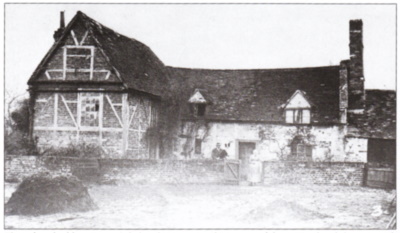
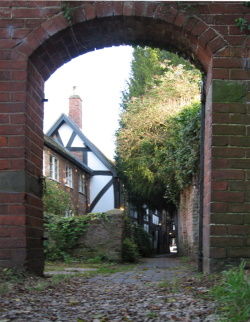
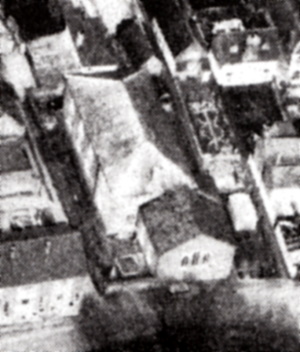
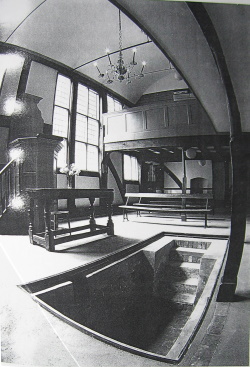
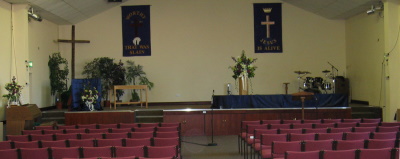
Comments
Saturday 6-Jul-2024 by: Chris Horner
You mention that Benjamin Purser built the Baptist chapel at Natton[6] in about 1720, as an annex to his farmhouse. Olive Constance Purser (1886-1973), descended from Pursers who migrated to Dublin in the 1770s (see her page on Wikipedia) wrote that her branch of the family was descended from a John Purser, a non-conformist yeoman of Shropshire who after the Restoration was find for church nonattendance, refused to pay the fine, had his farm horses distrained, but was aided by friends and became around 1700 "the leading figure in a small Baptist community near the town of Tewkesbury where the tiny meeting house can still be seen. His grandson another John Purser removed to London ..." and ultimately Ireland. Unfortunately, Olive Purser provided cited no sources for this information in a private letter to another relative. I am also a descendant of this family. Can you provide any further information on the Pursers of Tewkesbury? A still later John Secundus Purser (1783-1858), a partner at the Guinness Brewery, was definitely a Baptist, as he states in a diary he kept that has survived. He is a great-great grandfather of mine. Thank you, Chris Horner